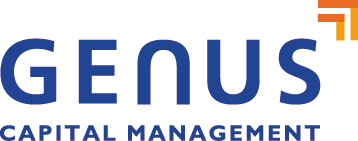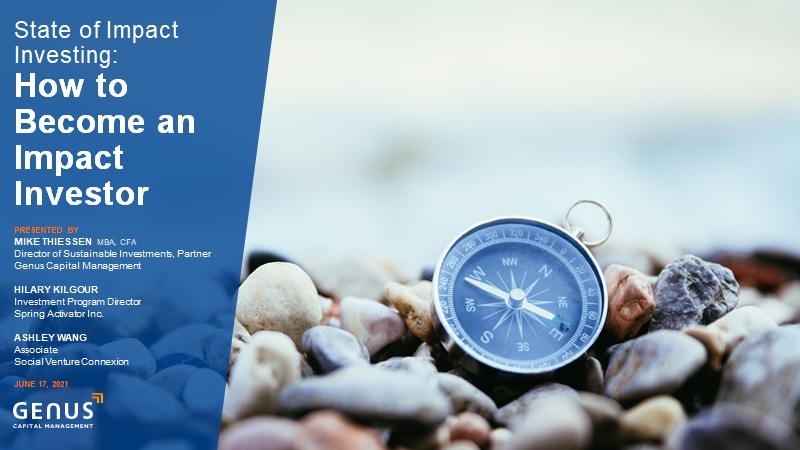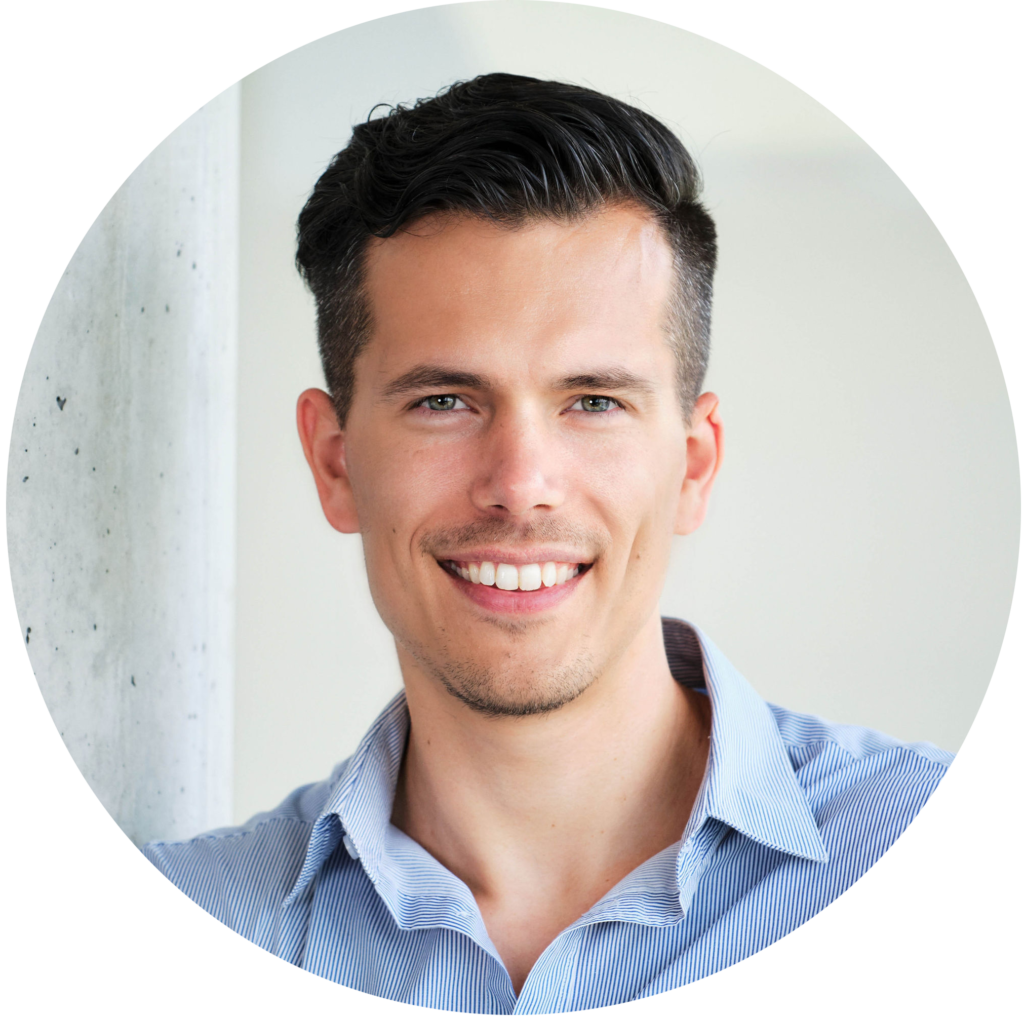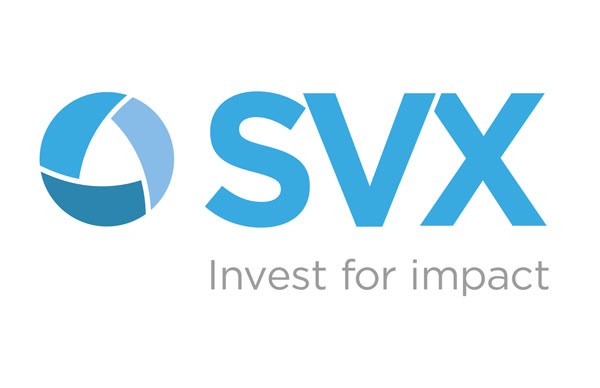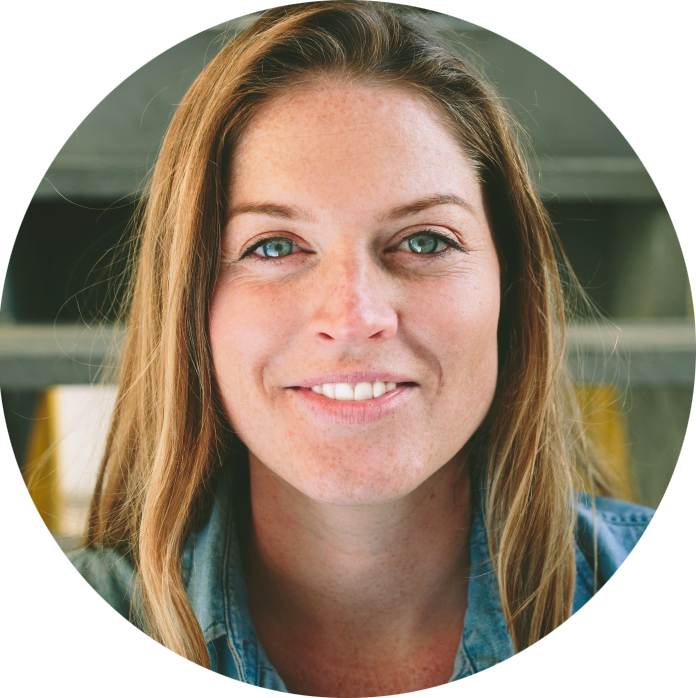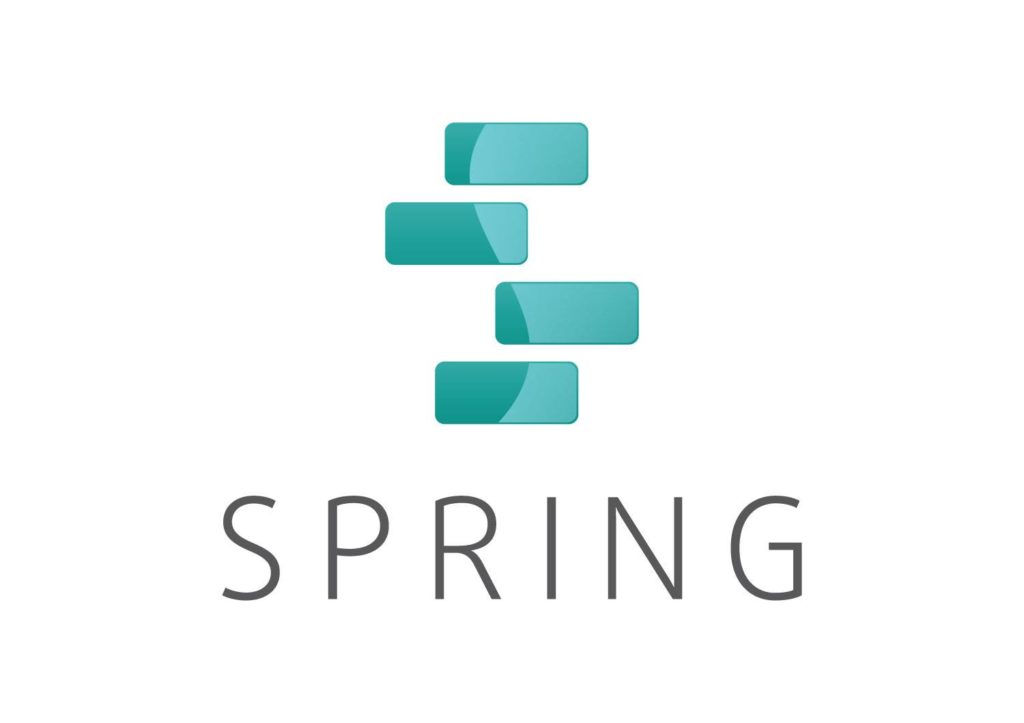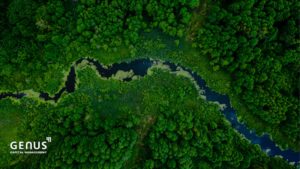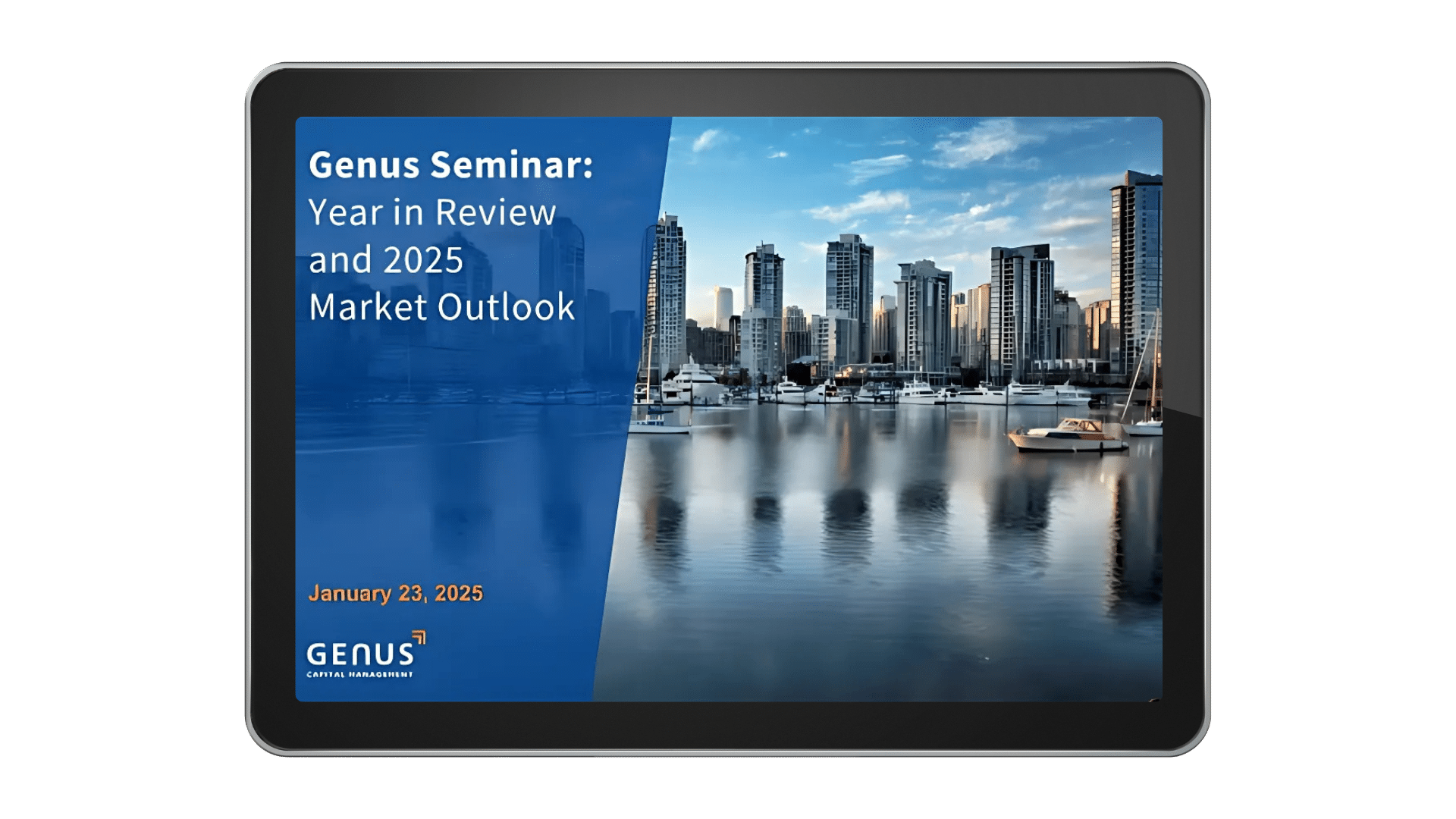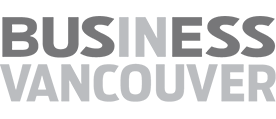Timestamp
[00:00] : Intro
[00:02:16-00:10:53] : Sue Talbot: What is Impact Investing and SDGs?
[00:10:57-00:20:33] : Hilary Kilgour: What is early stage investments and how to become an impact investor?
[00:22:59-00:30:11] : Ashley Wang: Place based impact investing
[00:32:50-00:41:52] : Mike Thiessen: Climate Action and Impact Investing
Speakers
Mike Thiessen – Director of Sustainable Investment, Genus Capital Management
Ashley Wang – Associate at Social Venture Connexion
Ashley is an Associate at Social Venture Connexion (SVX), where she works with social purpose organizations and impact investors.
In her position, she is also a member of the Women of Ontario Social Enterprise Network (WOSEN), where she designs and delivers programming for underrepresented women and non-binary entrepreneurs. Prior to her role at SVX, Ashley co-founded the London Social Value Fund, Ontario’s first youth-led impact investment organization. Ashley sits on the boards of the Social Innovation Academy and the Ontario Nonprofit Network and holds an HBA from the Ivey Business School.
Hilary Kilgour – Investment Program Director, Spring Activator Inc.
Sue Talbot: [00:00:04] Good morning and welcome, thank you for joining us today. My name is Sue Talbot and I’m a partner and portfolio manager at Genus. And today we’re going to build on the momentum created by our April Impacting Investment Webinar. I’ll be moderating today’s session. And with me today are three leaders in the Canadian impact investing space, Hilary Kilgour, of Spring Activator, Ashley Wang of Social Venture Connexion, also known as SVX, and our own Mike Thiessen. We’ve added a link to each speaker’s LinkedIn profile, and if you’d like to connect with them after the event, you can see the LinkedIn in the chat. Just one moment, please. I think we’re having audio issues. And I’m not sure if people can see my camera or not.
Mike Thiessen: [00:01:24] Do if you leave the stage and come back, then we’ll be able to see you. Some technical issues.
Hilary Kilgour: [00:01:33] We can hold the stage, for Sue while she’s back. Hi, everyone. Great to see you.
Sue Talbot: [00:01:41] Ok, I’m not sure what’s happening with my camera, people cannot see me, is that right?
Mike Thiessen: [00:01:50] We can’t see you.
Sue Talbot: [00:01:52] Sorry, everybody. I will try one more time. OK, I’m sorry, I don’t know what’s happening with my camera. I’ll just continue on. Sorry, everybody. So today we have three experts that are going to be giving us some insights on how to become an impact investor in Canada. And we are also going to be discussing several impact investment options as well. We want you to walk away today with an idea of what type of impact investor you want to become. And we’ll also provide some resources and clear action steps to help you get there as well. While we’re waiting for people to log in, I’ll just go over a few housekeeping items. First, if you’d like to maximize your screen, that will lead to the best viewing experience. And if you have any questions, please type them into the chat and we’re going to be able to have a Q&A session after each speaker and we’ll try to get to as many as we can. And if you’re having technical trouble like me, please write in the chat and we’ll have somebody on staff to try to help you through any technical issues. And often the solution may be to get out of the webinar and back in, and that sometimes solves the problem. But I don’t think I should do that. The webinar will be recorded and the link will be sent out after our session today.
Sue Talbot: [00:03:27] I’d like to start by acknowledging the indigenous people of all the lands we are on today while we meet today on a virtual platform, we would like to take a moment to acknowledge the importance of the land, which we all call home. We do this to affirm our commitment and responsibility in improving relationships between nations and to improving our own understanding of local indigenous peoples and their cultures. From coast to coast to coast, we acknowledge the ancestral and unseated territory of all the Inuit Maiti and First Nations people that call this nation home and who have taken care of this land. Canada is home to indigenous people from across Turtle Island and we are grateful to have the opportunity to meet and work on this territory. So before we get started, I have a question for you and hopefully you’ll see a poll question come up. And the pole is right next to the chat tab there, so hopefully everybody can see that. So the question is, how would you describe your level of engagement in impact investing? And you can see the answers. They’re interested, but not yet active early engagement through a few investments, actively building impact, investing in my portfolio and my portfolio focuses on impact alongside returns.
Sue Talbot: [00:04:53] And we have an other as an answer as well. So if you are choosing other, please let us know in the chat what your other is. And it looks like 33% are interested, but not yet active at 39%. So just we’ll just wait a little bit longer for people to answer and at 31%, actively building impact investing is my portfolio is the next popular one. So it looks like the majority of people have answered and the winner is interested but not yet active at 37% actively building Impact Investing in my portfolio is the second most popular at 31% And followed by early engagement through a few investments at 17% and nine percent my portfolio focus is on impact alongside returns and 6% or two people have answered others. So we go to the chat to see what the other is and I can’t see anything there. But that’s OK. So thank you everybody for participating in that. So the most popular answer is interested but not yet active. So that’s great. That’s probably why you’re here today to learn more about impact investing. So we’re going to be here to provide you with some answers. So impact investing has become extremely popular. And at a recent report from the Global Impact Investing Network shows that assets have grown globally from five hundred billion in twenty eighteen to seven hundred billion in twenty twenty.
Sue Talbot: [00:06:36] But in spite of this growth impact, investing carries some baggage. And the biggest misconception is that in order to do good, you have to give up returns. And this may sound back from when impact investing was first introduced. It’s a relatively new term, first coined in 2008 by the Rockefeller Foundation and back then impact. Investing more is more charitable in nature. Investments were made through grants and endowments and people weren’t really expecting a return. It was mostly about the positive impact of these funds. So obviously, if you were saving for retirement, this wouldn’t be very appealing. But investor preferences and demands shape change. And today, according to the Investment Funds Institute of Canada, there’s about 70 mutual funds and ETFs that are all dedicated to some form of sustainable investment strategy, while at the same time they’re also seeking to earn market like rates of returns as well. And if you actually look at the performance of these funds, you’ll see that in twenty twenty they had a stellar year of breakout performance year, but they also performed well over longer periods too. And according to a Responsible Investment Association report, if you looked at the three, five and 10 year return numbers, you’ll see that the average return either matched or did better than of all of the funds in the four major asset classes, which include Canadian fixed income, Canadian equity, global equity and US equity.
Sue Talbot: [00:08:11] So I think this dispels the myth that you need to sacrifice returns to align your investments with your values. The other challenge for impact investors is the fear of being taken in by greenwashing or impact washing. So how do I know that my investment is truly making an impact and how can that be measured? Well, here at Genus we make sure that our impact investments align with at least one of the 17 United Nations Sustainable Development Goals. The UN SDGs and these SDGs have been widely adopted as a way to measure impact based on the specific targets of each goal. And there’s also other impact tools available as well. There’s which includes a framework from the Sustainable Accounting Standards Board and the Impact Management Management Project as well. And I think Mike will be speaking more about how Genus measures impact in his session. And I think Hillary might also touch on the topic as well. Last year will soon not be forgotten. We dealt with a pandemic, we dealt with a devastated economy and social and civil unrest as well when reconnecting with their values. Investors are wondering how to build back better.
Sue Talbot: [00:09:28] Impact Investing can be seen as a way for investors to stand up for their beliefs while also investing for their future. So how do we get started? Well, there’s lots of options out there to start making a difference with your investments. And today we’re going to explore a few concrete ways that you can get started as an impact investor in Canada. A variety of options will be introduced and they may not be for everyone, but that’s really the point of this. So once you know what’s available, you can choose the path to impact investing. That’s right for you. Each of our speakers will be providing a short primer presentation on their area of expertise, expertise, and then we’ll open up for a short Q&A after each presentation. And there will also be time for additional Q&A, a session at the end as well. So please add your questions in the chat and you can add them at any time. There’s no need to wait for the end to do that. And we’ll start off with Hillary Killgore of Spring Activator. Hillary will discuss early stage impact investing, and there are a number of really innovative projects in the early stage impacting investment space. And I’m excited to hear more. So I’ll start my video, which I think has already stopped and handed over to Hillary. Thanks Hilary.
Hilary Kilgour: [00:10:57] Really good to see all of you coming from different perspectives to this conversation. I see a couple familiar faces and new faces or sorry, new names here. Great to have you joining us. So I’ll start just by sharing and I will start by sharing what it is. So I’m just trying to figure out how to move the slides forward. There we go. Thank you. So, yes, I get the chance to start with what is early stage investments and how to become an impact investor. So before we jump into that, I’m just going to give you a bit of context, which is I came to this space in the reverse order. So I actually came to a meeting with my parents investment manager looking at what it would look like to invest in the public market and then really starting to explore what did it mean to invest in more early stage companies. And I think that the thing that I’ll share there and just to give you a sense of the lens that I bring to this is I’ve come from the social entrepreneurship space. I got my MBA in sustainable systems. I worked in the corporate impact space for many years and really got a chance to see what does it look like to embed impact in large scale post IPO public companies. And to see the difference in that experience is ultimately why I came to the early stage place, which was I wanted to be investing in and be a part of early stage companies that we’re embedding impact from the start.
Hilary Kilgour: [00:12:26] And that’s one of the reasons that I really believe in impact investing. So we’ll go to the next slide, which gives you an overview of. Which gives you an overview of how popular this topic is in the news, so I just wanted to give you a glimpse and you heard Sue talking a little, speaking a little bit about what the significance is in terms of where we are in history, in terms of a pandemic. So we’ve seen a lot of funding being sent, both in terms of the clean tech sector to support that pandemic piece, but also making sure that we’re building this new this new feature, these these new companies. And we’ve seen a huge shift across Canada towards those investments is actually increased quite significantly during the pandemic. We’ve also seen a lot of people shifting towards impact, investing in early stage companies. And lastly, what I’ll say is we’ve seen entire sectors emerging. So a couple of years ago, Spring launched this impact challenge. I’ll speak a little bit more to today. And one of the winners winners was a company called Open Ocean Robotics. At the time, there were not a lot of innovations in the aquatic space. And since then and you’ll see in the Vancouver Tech Journal, they featured entire industry that’s now evolved in that space. So as we here we go last night in Campbell River, Spring had its impact, investor telling, some of you may have been there and we had five ventures pitch for fifty thousand dollars.
Hilary Kilgour: [00:13:48] Now, all five of them were early stage companies with a focus on how to advance impact in their spaces. Our winner last night was Hail Mary, but we had some great ventures pitching and really spoke to the strength of the ecosystem. And I wanted to highlight this both because this is a great example of what’s happening now and where you can get involved, but also a really great example of kind of the ecosystem approach that we’re seeing across Canada. It’s not just one company or one organization coming together. It’s many working together towards this. So spring, just give a little bit of context for those who you don’t know, spring spring works internationally, advancing social investment and social impact through education for both entrepreneurs and investors. So you’ll see we work all around the world really focused on on that key piece. Our team is strong and mighty and also very diverse for us. That’s really, really important that we have a diversity of perspectives, including a lot of strength in both the entrepreneurship as well as the investment side. And this is our mission, so not only do we speak very proudly about the fact that there is this ability to make change through innovation, but we are one percent for the planet certified as well as being a B corp.
Hilary Kilgour: [00:15:07] So we walk our talk. Just to give you an overview of what is early stage investing, so I’ve got some definitions here because I think we’ve all heard it and we heard Sue provide one as well. This one comes from the Global Impact Investing Network, so made with the intention to generate positive, measurable social and environmental impact alongside a financial return. I think that’s that’s the key piece to be keeping in mind. And when we think of angel investing, so really angel investing is that language around early stage investing, we often hear angel investors. What is that? It is an individual who’s investing in early stage companies and it is really important then I think it’s great that I’m starting tonight because heard today because these investments are risky. And and typically when I think of my own impact investment portfolio, they account for about 10 percent because they are early stage and there are there are risks associated. Wanted to walk through just a bit of the life cycle of funding and impact venture, you may have heard a lot of words like Precede Seed Series A, we’ve heard a lot of announcements in the news over the last few months as well as over the last few years. So I just wanted to give you a sense of kind of where that early stage sidewalls. So a company that’s got an idea it is exploring is really in that early stage precede. We know we’re very familiar with friends and family.
Hilary Kilgour: [00:16:31] Some of you may have been apart or gotten options to be a part of a seed stage really in that precede seed startup stages when angel investors start to have the opportunity to be part of a venture and and fund them to get to that critical next step, which is being able to access larger funds or larger capital options. So when we really think Precede is in that launch stage, one of the one of the key things you’ll hear tonight or today you’ll hear is IPO. What does it look like to be helping a company towards an exit? When we think of an exit, it can look many different forms. But you really are at an early stage investor being a part of that journey with the company. So you want to look, when I think of my investments, I’m looking at kind of a five to seven to eight year time that I’ll be with that venture. When you’re thinking about what to focus on, this is often the hardest thing for for new investors is how do I focus my investment? These are some of the things that we emphasize to participants in our programming is you want to really think about what return and type are you looking for? What kind of risk are you willing to take? What industries are of interest? And perhaps more importantly to that, what industries do you have a lot of expertise to offer? Because early stage investors get that opportunity.
Hilary Kilgour: [00:17:51] What geography are you looking at? Exit time horizon as well as how involved do you want to be? I’m going to speak to this the spectrum, and I think what’s really key about this is no early stage investor is alike. You are all coming from a different perspective, a different belief, and that really comes into form in that impact thesis. And you see it takes shape in the type of investments that look interesting to you. So classic investment looking at very competitive returns. We also have more values based screening, which as a QIO activator is something that’s really, really important to me as my investments. And then you get to some of the really impact focused pieces. So they’re all impact. It’s just a different type of impact. And when we talk about impact, we often think of the depth or scale or breadth. So we’ll shift to some tangible things that you can do and then happy to answer any questions that come up. So this is the process of impact investments, introductions, pitch, due diligence, negotiation and post round that’s very simplified and never quite looks like a linear thing, but wanted to give you an overview. And then tomorrow, tonight, that’s why I keep using the word tonight is we actually have five ventures pitching for the first national impact investor challenge. You may see some companies in there that are familiar to you. You may also see that Genus Capital Management is one of our partners, which we’re really honored to have as part of that.
Hilary Kilgour: [00:19:16] So tonight, five companies will be pitching for one hundred thousand dollars from investors and again, encourage you, if you’re interested, some of the criteria that those investors are using as they make those decisions. Some of the factors, as I mentioned, in terms of your impact, this factor into those decisions, and then the team here will share a link to this impact thesis guide, which if you are just getting started and you’re thinking about which investments you want to be looking at, this is a great way to walk through that and get a sense of what might be a fit for you. So my challenge is to you, if you’re interested in getting into the early stage investment space, if you are already and you want to refine it, is to draft your impact thesis, get a clear sense of where you are on that spectrum and identify three leads that are interest to you. Lastly, I already share that we’ve got the finale tonight, which we’d love to see there. We have an impact investor event happening in Ireland next week. If you’re invited to join and we have my timer goes, we have the impact challenge, both in Vancouver happening next year as well as Saskatchewan in the fall if you’re interested in joining a cohort based investment opportunity learning with others. Thank you Sue. So that that’s what I’ve got for today.
Sue Talbot: [00:20:34] Great. Thank you very much, Hilary, for that summary. Let’s ask everybody to come back to stage. I noticed my videos working out great with you. Just waiting for Ashley to come back. And just a reminder, everybody, you can please enter any questions in your chat. But we have we have one question here for Hillary, and that is, how has the pandemic affected investment opportunities in the private market, particularly particularly at early stages ?
Hilary Kilgour: [00:21:12] There’s two sides of that question, which is, one, the Canadian space has seen a significant increase in investments, particularly in the impact space, because investors are now looking at how do I make sure that my early stage investments match the type of portfolio that I’ve had from a from a place of impact. So we’re seeing a huge increase in people who are interested in the impact investments, particularly in the early stage. The second part of that is I will say it’s different types of investments. So you might be thinking a traditional portfolio is looking at like equity and investing so that you get equity in response in return for your investment. We’re also seeing a lot more at investments because of companies going through a pandemic who do have debt situations that they want to make sure that they’re getting support for. So we’re just seeing different types of investments in that space.
Sue Talbot: [00:22:06] Ok, great. Thanks, Hilary, for that. So we’re going to move on to Ashley next. I think I figured out what the problem is with the video. I think we’re only allowed three at a time. So I think it won’t all leave. So that’s probably what’s happening. So next up, we have Ashley Wang and I will I will exit. And so so her video will come up. And Ashley is from SVX and she’s going to discuss place based impact investing and place based impact investing allows investors to target opportunities that help local communities or regions. And I know supporting local communities is really important to a number of my clients, especially after the events of the past year or so. I will hand it over to Hillary.
Ashley Wang: [00:22:59] Great, thanks so much, Sue hopefully everyone can see and hear me now, but really happy to to be with everyone today. I don’t have a ton of air time, but hopefully we’ll be able to get to a bunch of your questions at the end, too. So Ashley Wang, associate with SVX Social Venture Connection. I come from a background of corporate social responsibility, research and social enterprise programs, and I currently lead due diligence and investor relations with SVX. So a large part of my role is working with impact investors like yourselves to mobilize their capital towards profit and purpose. So again, super excited to be with you. All right. So quick disclaimer before I kick into my presentation and you’ll see below. And in terms of how this presentation is going to work, it’s going to follow a similar format to Hillary. So we’ll talk a little bit first about SVX and we’ll do an introduction to place based impact investing. And then we’ll share specifically some action items on what you can do to get involved in place based impact investing, if that’s what’s piquing your interest. So to kick things off, we’ll just talk about SVX quickly, and we’re a non-profit, diversified financial services firm, so we work with a variety of organizations, funds and enterprises again, as well as with investors like yourselves.
Ashley Wang: [00:24:28] So from foundations to family offices, faith based organizations to individuals, we work across impact sectors like climate, food, health, social inclusion. And we are also registered as an exempt market dealer in terms of our services. We provide venture and investor education, capital advisory, fund design and management, particularly in place based on design and management. And we also operate a platform for raising impact capital and making impact investments. If you have any questions about SVX, I’d be happy to answer them. Feel free to pop them in the chat. In terms of play space, impact investing, I’m really happy that you were able to hear Hilary’s presentation first, because a core component of that is the impact investing definition. So investments made with the intention to yield measurable financial as well as social and or environmental returns. The additional layer that place based ads to play space impact investing is that it refers to the local deployment of impact capital. And so this local deployment specifically addresses the needs of particular communities, regions or ecosystems. So say you’re an impact investor who is interested in indigenous economic development. You might invest your money with an organization like Entrepreneurs that focuses on empowering indigenous and community based entrepreneurs in northern Canada. Or say you’re an investor living in London, Ontario, and you’re really interested in making an impact in your local community.
Ashley Wang: [00:26:04] You might invest with an organization like Virge Capital in the image here that supports social enterprises across southwestern Ontario in particular. So now that we have a sense of what place based impact investing is, some trends that you might want to be aware of first, that place based in fact investing is is really taking root. And so if this concept sounds interesting to you of investing in your own backyard, so to speak, this is an opportune time to get involved. There’s been a foundation of place based impact investing built already through North America. And so billions have been deployed over the past year through the existing Community Development Financial Institution Network or Severe Network and the US with additional announcements. There was one yesterday from Kamala Harris of another one point five billion that will be deployed into that network with tons of new initiatives in the US, UK, across the globe really. And in Canada, more initiatives and more funds popping up each and every day, as well as a recent national survey that we conducted reporting that about 80 percent of active impact investors were interested in seeking out opportunities that benefited local communities or regions. And so to make this come to life, we’ve just created a list of examples that you can look into here in Canada as well as globally to do your own research into what might be interesting to you in terms of place based impact investing organizations that you might want to look into more.
Ashley Wang: [00:27:42] So now just making things super tangible for all of you, we’ve pulled together four key steps that you can use to get involved with play space impact investing. And so the first is to join the movement currently is building a movement called Impact United. It’s a community and movement of asset owners across Canada that are looking to mobilize their investment capital toward social, economic and environmental justice. And we hosted tons of events. We have strategic initiatives and we also operate an online network for our communities of practice. And so those will range from topics like play space impact investing to climate action, which we’ll talk about later. And so we would urge you to join, since you’re likely aligned with that cause if you’re on this call. Second is to build your knowledge, and so I see that atoms already put in some of our resources into the chat, but please feel free to read up on please impact investing from a variety of resources. SVX has created a whole bunch and as well joining our investor education programs, as well as the ones run by organizations like Spring that Hillary works at.
Ashley Wang: [00:28:57] You can also connect with local intermediaries, and so that might be community foundations, angel groups, community loan funds, organizations like SVX, if you’d like to learn more. And finally, I will just call out that you might want to have a conversation with your advisor or manager, so if play space impact investing is of interest to you. Ask them to make products available to you, share your interest with them, and potentially even update your investment policy statement to make either impact investing or play space impact investing a priority. So if you want to get started, I do have one event that I can share with you that you can hop on as early as next week. So this one is an impact in the event that we’re hosting specifically on climate action on June 20 seconds of this upcoming Tuesday, there will be future events for play space impact investing as well. So you can look out for those, too. And I believe the event link will be put in the chart for us, if you would like to register. So there’s lots that that you can do if place based impact investing is of interest and we’re super happy to support you in your journey. So feel free to just give us an email and we’d be happy to support you. Thanks.
Sue Talbot: [00:30:12] Great. Thanks, Ashley, for that. And just a reminder for everybody, if you have any questions, please go ahead and enter them in the chat and there will be an opportunity for another Q&A session after the speakers as well. So we do have one question for you, Ashley, and that is where is place based impact investing starting to emerge in Canada? Can you give us some examples of communities or regions?
Ashley Wang: [00:30:47] So that question, what’s really special is that placee based impact investing is kind of emerging everywhere in tons of different pockets across Canada. And so some of the organizations that we listed on that example fly from private capital, which is on the Sunshine Coast in British Columbia, all the way through to the St. John Community Loan Fund, which is way up in the Atlantic. So it’s really emerging in pockets kind of everywhere across the nation. And so there’s a lot of activity that is happening and is really reflective of where we are in the ecosystem right now. So it’s an exciting time to get involved. And these place based organizations are emerging in pockets really where the need is and where there are strong community actors that are taking the risk to be involved and to really drive things forward. And so particularly in, for example, rural communities, we’ve seen in Ontario, Prince Edward County, one of our partners on a fund that that we’re working on right now has been really involved. And they’ve been able to take the needs that they’ve seen in their community and really drive forward and respond to the specific needs of the rural community. And so it’s emerging in various areas and more and more, again, pop up every single day.
Sue Talbot: [00:32:10] Thank you for that. So we’ll move on to our last speaker, and that’s Mike Thiessen, and Mike is our director of Sustainable Investments, and he’s going to talk about climate action, impact investing. And this is where you’re directing investments in companies that are actively seeking to reduce or or remove their CO2 emissions. And we all understand why it’s important to reduce our carbon footprint and prevent global warming. So I will ask Mike to come up to the stage here.
Mike Thiessen: [00:32:46] Hi Sue.
Sue Talbot: [00:32:47] Hi, Mike,
Mike Thiessen: [00:32:50] Great. Thank you so much, Sue, and hi, everybody. Great to see a lot of familiar names out there. As as you said, I’m the director of the Sustainable Investments at Genus. So climate action impact investing is a big passion of mine. And it has to do with saying it’s there is a big why behind the climate action. We all know what’s going on with with climate change, the physical changes that are happening to to our to our environment and the physical risks for the future, which we need to be mitigated. So us as individuals and investors, organizations and then our governments need to be taking action and making a difference in this area. And that’s why impact investing in our climate is so exciting, because you can make a direct difference with your money. So we know why. I thought it would be great to go into just the very basics of kind of what we’re doing when we’re when we’re focusing on climate action, impact investing. And I saw from the poll earlier that a lot of people are interested in impact investing, but haven’t quite gotten involved yet. So I think it’s great to kind of go go through kind of what we’re doing with this with with climate action and impact investing. So as investors, where we’re moving money into environmental impact investments, our climate climate action impact investments. So that might mean we’re investing in infrastructure.
Mike Thiessen: [00:34:24] So it could be a solar utility or it could be clean technology or it could be a large corporation that’s focusing on energy efficiency. But all these investments are making long term reductions in greenhouse gas emissions. And that’s the goal of these investments that we’re making. And with this reduction in greenhouse gas emissions, we’re often able to measure this often quite precisely with climate action impact. And that’s one of the one of the great things about climate action impact investing is measuring your impact is often often easier than other areas that are more that are more kind of qualitative in nature and are just are making just as much impact. But it might be harder to measure. So we’re getting that impact data, which is so important because we want to make a measurable impact and then also making financial returns. And so I want to talk quickly about financial returns before I go on to some practical examples of climate action impact, because I know it is a big issue. I don’t see you mentioned it, Hillary mentioned it, but I’ll talk to you as well. It is a common myth that we have to be giving up returns in order to make an impact. But there have been studies, very prominent studies done by great business schools like Wharton, some done by other organizations like the IFC or like Ginne that are showing that over the long run impact investing does lead to it does lead to market returns.
Mike Thiessen: [00:35:58] And you can get returns that are that are just like your benchmark and your benchmark. And we’ve seen at Genus with our high equity funds and other good investments that we’re able to have market like returns as well. So it’s certainly not a guarantee that you’re going to have market like returns, but it is something that you can have and you can be a smart, sophisticated investor and an impact with your money at the same time. So on some practical examples. So one area where you can make climate action impact is with public equities. So here are just a few examples of some public equities that we’re investing in. So public equities like SMA Solar is an innovator in solar panels in Europe and they sell solar panels all around the world. Also, companies like Segro. So Segro is Real Estate Investment Trust, also a developer of real estate by focusing only on low carbon real estate. So really being a leader in that area. And then companies like Schneider Electric, which is producing equipment and technology to advance energy efficiency. So not only within their company, but in other companies as well. They also do a lot of consulting with utilities and then energy efficiency projects as well.
Mike Thiessen: [00:37:19] So with public equity climate impact, you can you can make a big impact. It can also be quite liquid. You can get in and out of these investments quite quickly. And so that’s often a benefit for a lot of a lot of investors that may be able to have a portion of their portfolio in kind of longer term locked in liquid investments. But they may need the liquidity as well. And there are funds. Genus has a high impact equity fund that invests in these climate action impact investments, along with other impact investments as well. Another more liquid area of impact investing around climate is green bonds or impact bonds, so green bonds are bonds where the proceeds are used towards green projects. So these projects could be things like renewable energy, low carbon transportation, energy efficiency, could be other innovations around around the environment. And and these these projects are certified by different third parties. So it could be the Climate Bond Initiative or other third parties that are looking at the issuers and making sure that these processes actually are going towards these green projects. And so there’s corporations around the world issuing green bonds for green projects that they’re doing. There’s governments. So government of Ontario, governments of Quebec have been issuing green bonds, which the government is supposed to be issuing rebind as well.
Mike Thiessen: [00:38:48] And then large supernaturals like the World Bank are also issuing green bonds. So these are liquid impact investments that you can get in and out of quite quickly as well. And so Genus, about a month ago launched a global impact bond fund. So this is a fund where we’re investing in a diversified portfolio of green bonds all around the world so that our clients can make an impact in the fixed income liquid space. And then also there are private impact investments, and that’s what Hillary and Ashley have mainly been focusing on, is the private side. And with private impact investments, you can make very direct impact and you can often have some influence on the companies that you’re investing in because you might be only one of a few investors rather than one of possibly millions of investors for large public companies. And here you can you can invest in infrastructure. You can invest in private debt. You could invest in a real estate, venture capital, private equity. And so we have a few examples here. So so one is the One Planet Living Fund. So this is a fund that is developing low carbon and affordable real estate in Canada. We also have been doing analysis of Initio, which is a venture capital fund, investing in breakthrough technology around advancing decarbonization. So it Initio Chris Reid, who you may have listened to a few weeks ago with one of our webinars, is quite involved in an issue he’s quite, quite advanced in in in hydrogen and hydrogen technology and then Active Impact I think Active Impact has come up in Hillary.
Mike Thiessen: [00:40:33] And I think Ashley’s presentation as well there in early stage climate tech venture capital fund. So these are some private impact investments examples. Your you have less liquidity so your money could be locked into these funds for for 10 years, 12 years. There’s private debt investments where your money could be locked in for maybe five years. So you don’t get that same liquidity, but you do get kind of more direct impact with these. And Genus, along with SVX, creates private impact portfolios for clients. So we fully customized private impact portfolios for our clients and across asset classes, focusing on the impact that they’re wanting to make, whether that is climate action or maybe it’s maybe it’s health or maybe it’s a place based, focused and will will help investors get into different private investments. Also public, more liquid investments as well. So overall, climate action impact investing is an exciting place to be right now. There’s been a lot of growth, especially in the last few years. And I think it’s an area where we can really have an influence on the transition to a lower carbon in the world. Well. That’s all for me.
Sue Talbot: [00:41:56] Thanks, Mike, for that. So we just have one question for you, and that question is, can we entirely replace fossil fuels with renewable energy or is this a pie in the sky goal?
Mike Thiessen: [00:42:12] I think I think we eventually can. I think that it’s going to take a while to get there. There is a lot of investment that needs to take place. There is a lot of infrastructure building that needs to take place. There’s a lot of technology that needs to be that needs to be built as well. So it’s going to take a while to get there. But but I think that it is possible. But in the meantime, there there needs to be a transition. We still need to keep the lights on and we still need to have hospitals, schools, houses running. And and so there needs to be a transition period. So within that period, we need to be focusing more on lowering the carbon emissions of the of the energy that we are producing. But as far as climate action impact investors, we can really choose where we want to be financing. So maybe it is technology that you want to be financing that’s going to be advancing our our movement towards these renewables. Or maybe it’s investing in the infrastructure itself. But I think that you can make a difference with your investment dollars in getting us there.
Sue Talbot: [00:43:19] Ok, great. Thank you. And Ashley, Hilary, do you have any anything to add to that? OK, great, so let’s there’s a couple of questions in the chat, so I’ll I’ll have a look here. So this one is probably directed to Hillary. And the question is how early these how early can you get into these investments? So if they’re if they’re Cedeño sales yet, is it is that OK as an example?
Hilary Kilgour: [00:43:56] The question I think at the end of the day, it depends on your your thesis of how early you want to get in, but also where you see yourself adding the most value. So that is actually one thing that I want to emphasize with early stage investments is they’re a bit less passive unless you want it to be less high touch or low touch investment. So what? So what I will say is earlier the better. What I will say is we talked about what you want to be looking for. You do want to see traction. So if not revenue traction, you want to see proof of where they’ve had significant gains before you invest in a company. I wouldn’t recommend investing in a company at the idea stage. You really want to see that they are further than an idea and that they’ve really demonstrated some traction in the market.
Sue Talbot: [00:44:49] Right. So it sounds like it should be doing some due diligence as well before before you make that decision. So this question might be directed towards Ashley and it’s a place based impact investing. So are there any opportunities globally?
Ashley Wang: [00:45:12] Yeah, and so thanks for that one. I think the you know, the thesis around play space impact investing is is really reliant on the core tenant that the organizations running the place based intermediaries are funds really know the communities deeply, and so they’re able to decide kind of what issues they want to focus on, say, if they’re operating in Vancouver or on the Sunshine Coast. As one of our examples do. It’s really important that they understand, you know, is indigenous economic development really important in the area? Is it climate action that we or homelessness that we really want to tackle in the place, in the community that we’re focusing on? And so if you’re kind of interested as as an organization that perhaps has a global mandate, you can invest into these place based organizations that might have that narrower focus as a way for you to focus in on the communities that you’re interested in. And so quite interesting, I think, to think about are there any global opportunities? There might be. But again, the key kind of component of it is that whoever is running the organization really knows that the needs of those communities best, and that’s often by being situated in those communities. And so there’s opportunities there. But really trying to find a way to have corporations or governments invest in those local communities. It might be through a mechanism like a place based investing. So hopefully that answers your question.
Sue Talbot: [00:46:54] Right. Thanks, Ashley. That makes that makes a lot of sense. So here’s a question probably for Mike. And it is, what are the critical things that one needs to look for to avoid investments that are not truly contributing to climate issues, such as avoiding greenwashing?
Mike Thiessen: [00:47:14] Mm hmm. This is a quite a common question and a very important question, I think. I think there are two different ways. It depends on the investment that you’re looking at. If you’re looking at a fund, then I think one of the key things to do is to actually look into the fund and see what’s there. I think there are a lot of green labels on funds right now, especially after 2020 when environmental investing was very hot. Then a lot of a lot of asset managers, a lot of financial firms are coming out with with green funds that are necessarily green. So I think one key aspect is to actually look into the fund and see what’s in there and do do the investments within the fund match. What I think is, is mission climate action, even though that seems simple, I think that’s you often find surprises in some of these group funds. And then and then I think you also want to look at measurement of things like carbon intensity for funds. So if if you are investing in a fund and your advisor or the person that is connecting you to the five is be able to find what the carbon intensity is or what their what their overall, I guess, theory of change within the company or within the fund is. Then then there’s big question marks around that, whether this is an actual green five or not. And then what I think you’re looking at individual investments. You want to be looking at both their their intentionality of trying to accomplish different, accomplished, different or fix different problems. And then also the measurement of of their of their climate mitigation. So I think yeah, I think you really want to focus on measurement, whether it is with an individual company or with a fund. But but really, you just need to be diving deeper into these investments.
Sue Talbot: [00:49:17] Right. And it sounds like measurement is the key here. When when you’re looking at impact investing, it’s important to actually do a deep dive into the investments, as you said. OK, so the next question will be for the three of you and we’ll address this with Hillary first. And what other interesting trends and impact investing are you seeing beyond that? The three that we discussed today as an example, diversity, equity and inclusion, indigenous impact investing and others. So, Hilary, we’ll start with you.
Hilary Kilgour: [00:49:53] Yeah, I’ll speak to that from a diversity lens. I think one of the things that we’re seeing, particularly actually build off of what Mike was saying from a measurement perspective, is when you’re looking at companies to actually look at what their theory of change is or how they’re communicating the impacts that they’re going to have as they grow. So one of the. Navigant trends that we’re seeing is embedding as you grow, how is the diversity of your community, your workers, the impact that you’re having as a company? Those are really critical things to be seeing. And I think for a very long time, we’ve seen vanity metrics around that, to be frank. And what we’re seeing is we’re seeing a lot more maturity in the market, but a lot more of accountability that investors are holding companies to account at all stages. And so I think that’s that’s really significant. It’s also gives me a lot of hope. What I will say is working in the Sheeo community and being very involved in that. We’re seeing a lot of people coming together and working together. And I think that, you know, if we think of where Canada was from an impact investment space, even 10 years ago when I actually had to go to the states to study this, we’re actually seeing a lot of movement in a positive direction towards both education around this, but also in terms of we’re seeing incubators, accelerators, who are really embedding the theory of how to make and build a business from the ground up that has impact embedded in it rather than added on later. And I think those are really positive trends that we’re seeing.
Sue Talbot: [00:51:22] Thanks, Hilary. Ashley, how would you answer this question?
Ashley Wang: [00:51:27] Oh, thanks. Just making sure you can both still hear me and see me OK. I have a very interesting Zoome situation, but I think I’ll take a bit of a different approach to answering this. And I think, Sue, you touched on a couple different trends in terms of different sort of sustainable development goals, perhaps that that investors might start to be interested in. And I think what we’ve seen, particularly in light of the pandemic in the past year or 15 months or so, is that marginalized and underserved communities have been really hit the hardest by this pandemic. And that includes racialize people, that includes women or indigenous communities. And, you know, there are a variety of issues that come out of the pandemic that I’m sure you’re all quite well aware of. But I think what’s really great, the silver lining of the pandemic, is that now there’s an increased focus on kind of lifting all boats in a sense, and really taking that equity lines rather than just looking at climate, which is important, of course. But there is that intersectional lens that we need to bring to all aspects of impact. And so I think there’s a really increased focus on those types of of investments that will really boost the underserved communities that we have in Canada.
Sue Talbot: [00:52:54] Great. Thanks, Ashley. So we’re running low on time here, so we’ll have to end the Q&A session here. And thanks, everybody, for submitting your questions in the chat box. And if we didn’t get to your question today, we’ll reach out to you after the seminar and we’ll try to answer everyone’s questions. So thanks again to the three of you for your great insights. And we’re going to wrap up with closing panelists thoughts. So we’ll start again with Hillary on her, her closing thoughts.
Hilary Kilgour: [00:53:29] Thanks for having us today. It’s really a pleasure to be here. I think that the thing that gives me the greatest hope, but also tangible action, is that we are seeing a growing number of companies move in this direction. And so we are seeing companies not only build their companies based on real problems, but we’re also seeing investors and board members holding companies accountable for what they’re doing from an impact lens. And I really want to build on what Ashley just said, which is it’s about people at the end of the day, it’s about the people and the people who are a part of it. And and the last thing I’ll say from an early stage investment perspective is it’s about people. It’s about relationships and getting to know people. So I encourage you to go out and find two to three leaders. That would be a good fit. That really is about finding people that resonate with what your vision and what your vision for the future is and how you want to be a part of it.
Sue Talbot: [00:54:25] Great. Thanks, Hilary. Now on to Ashley.
Ashley Wang: [00:54:31] Great there. Thank you so much for having us today. It’s such a pleasure to be able to speak to almost 50 of you on this topic. I think that just speaks to the growing interest in this sector for not only profit, but integrating purpose in there as well. So that’s that’s really special. And the growth has been explosive even in the past year or so on the play space impact investing front. And we conducted a survey recently, as mentioned, and there was significant interest in place based impact investing. But I think what was even better was that most folks who answered our survey as well spoke to wanting to increase the percentage of their portfolio that goes towards impact in general. And so I think, again, just speaking to the growing interest, not only from investors, but from the rest of our community as well, to just get involved and to build back better. And so really using that term, I think, is the guiding light for us over the next few years or so. So thanks for having us.
Sue Talbot: [00:55:38] Great. Thanks, Ashleigh. And last but not least, Mike and I realize Mike, sorry I skipped that last question. I didn’t get your answer to the last question. And we do have a couple of minutes. So before you give us your final thoughts, maybe you can ask the question, answer the question about what you see are interesting trends in impact investing today?
Mike Thiessen: [00:56:00] Sure. I certainly agree with Ashleigh and Hilary, even in their trends that they brought up. I think one other trend that that we’re seeing with with a lot of our clients, especially in twenty twenty, was wanting to move into sustainable agriculture and looking at food supply chains, especially in Canada, you know, so that does that is certainly linked to place based investing. But I think we did have scarers last year with our supply chains around food. And I think for years people have been concerned about the quality of our food chains and how sustainable agriculture is. So I think there is movement in that direction as well. And there’s some options there, too. And we have been helping clients get into some sustainable agriculture investments. So that’s a trend that we’re seeing as well. And in terms of any remarks, I think I mean, this can be it can be quite overwhelming. There are so many areas of impact that you can be making. You could be doing places you could be doing early stage, you could be climate. And there’s many other areas as well. But I think a good starting place is to figure out what your goals are, what changes you are wanting to be makes you are wanting to make. So using a framework like what Hillary was showing the spring kind of framework for figuring out your impact goals, know SVX has a good kind of a booklet to go through to figure out your impact goals. And the advisors at Genus could certainly help people with their with their impact goals as well, too. But I think taking that first step, figuring out what impact you’re wanting to make is really key rather than rather than seeing all this information and being overwhelmed. I think it’s good to take that step and figure out what impact you wanted to make.
Sue Talbot: [00:57:53] Great, thanks, Mike, and thanks to all our great expert panelists as well, so we’re going to sign off now. Thanks to everyone for taking the time to be here. And this has been really informative. And I hope we’ve given our audience some ideas and clear action steps on how you can get started on your impact investing journey. So thanks again, everybody, for being part of the webinar and to our valued clients. Thanks for attending and for people that are new to join us. Thanks for attending as well. And it’s an honor to be able to put on these webinars and learn together and learn together so that we can be more sustainable investors. The next Genus webinar will be in the fall. So please check your inboxes over the summer for the invitations and please stick around, because as soon as we sign off, you’ll be redirected to a survey. And we’d love to know your thoughts and feedback on how we did in the session today. So thanks again to our speakers and thanks to everybody for watching. Have a great day.
